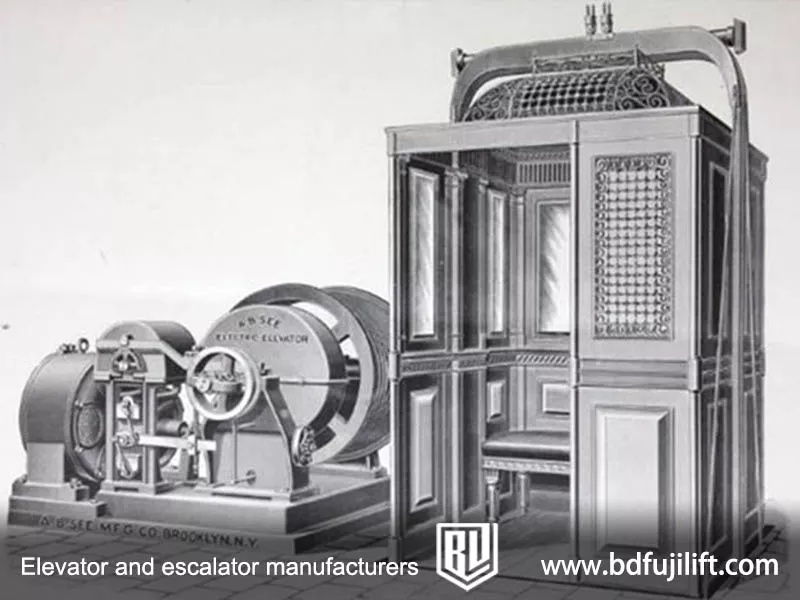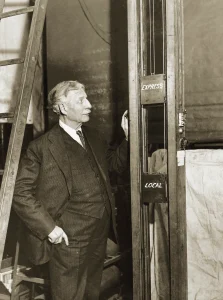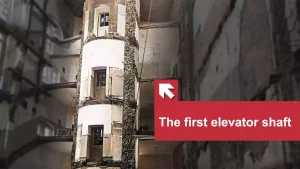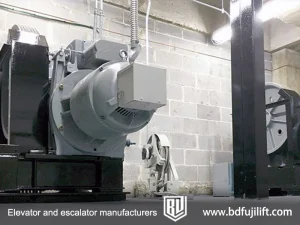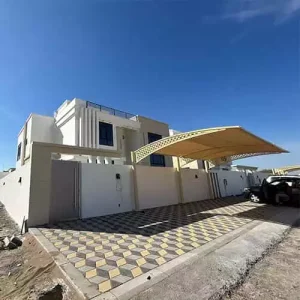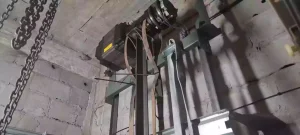The elevator is crucial for the construction of skyscrapers.
We now take elevators for granted. But before the 19th century, people couldn’t imagine using them. Early elevators were not made to carry passengers.
So, how were elevators invented? How did they become the modern elevators we use today? Let’s explore the history of elevators.
A Brief History of Elevator Development
- 236 BC: Greek mathematician Archimedes invented the pulley and winch system, an early form of elevators.
- 1793: Russian inventor Ivan Kulibin installed the first screw-driven elevator in the Winter Palace.
- 1834: Albert invented strong iron ropes, making elevators safer.
- 1852: Elisha Otis invented the safety elevator, which solved the risk of rope failure, and demonstrated it in 1854.
- 1857: Otis installed the first commercial passenger elevator in New York.
- 1870: The hydraulic elevator was introduced, replacing steam-powered elevators.
- 1880: German inventor Werner von Siemens created the first electric elevator. This marked the start of electrification.
- 1900: the automatic elevator was introduced. But, public trust grew slowly. A 1945 elevator operators’ strike helped speed up its adoption.
- 1982: France, Germany, and Japan developed the linear motor elevator, which was used in Japan in 1989.
- 1990: Mitsubishi Electric applied variable frequency drive (VFD) systems to hydraulic elevators.
- 1996: Finland’s Kone launched the MonoSpace elevator. It had no machine room and featured new motors and speed control.
- 1997: Schindler introduced its MRL elevator, the MOB.
The Origins of the Elevator
Elevators have a long history, dating back thousands of years.
236 BC: Early Elevator Prototypes
The first elevators likely appeared during the construction of the Great Pyramid of Giza. Workers may have used rope systems to lift heavy materials.
Around 236 BC, Archimedes invented a pulley and winch system. By wrapping a rope around a wheel with a heavy load, he made it easier to lift objects.
These devices were powered by human or animal labor and were commonly used in ancient Greece.
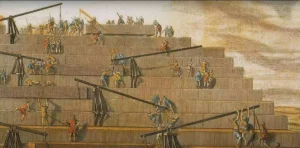
1st Century BC: The Most Complex Ancient Elevator Systems
By the 1st century BC, the Roman Colosseum used advanced elevator systems.
At that time, 24 cages were operated by 224 slaves.
Each group of eight slaves controlled a winch. These winches, connected by ropes and pulleys, quickly raised the cages to the arena.
This system worked well, lifting items in just seconds.
These early elevators were mainly used to lift heavy objects. They relied on ropes for power but had no safety features. A rope failure could cause serious accidents.
As technology improved, elevators became the modern systems we use today.
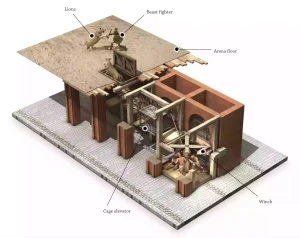
The Development of Elevator Technology
The early development of elevator technology was driven by the needs of royalty.
1743: Louis XV’s “Flying Chair”
In 1743, King Louis XV disliked climbing stairs. He wanted an easier way to visit his mistresses on different floors.
He asked mechanic Blaise-Henri to install a “flying chair” in his apartment.
This “flying chair” was driven by the elevator’s internal ropes and equipped with a counterweight and pulley system.
Louis XV also designed a “flying table” to send food up and down, so he could dine alone without servants.
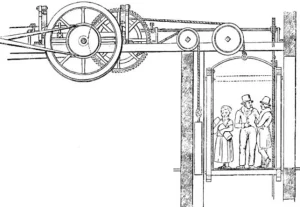
1793: Kulibin’s Screw Elevator
In 1793, Russian inventor Ivan Kulibin installed the first screw-driven elevator in the Winter Palace.
The elevator cabin moved up and down a spiral track.

The 19th Century: The Industrial Revolution and Elevator Demand
The 19th century saw the Industrial Revolution, which changed society in many ways.
This shift increased the need for elevators, especially to move goods and materials. As a result, elevator technology improved.
Early lifts were mainly used to carry timber up slopes and coal from mines.
Winches had been used in mining for centuries, but by the 1880s, steam engines took their place.
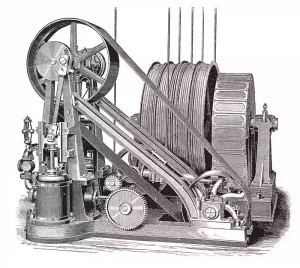
1830s: Steam-Driven Machines and Early Elevator Challenges
By the 1830s, steam-driven machines were common in European mines and factories.
But, most elevators were simple lifting platforms. They lacked safety features to prevent falls. More importantly, the ropes used in these elevators often broke, causing accidents.
In 1859, some regions in Germany banned rope-driven elevators due to these risks.
The frequent rope failures made miners afraid, as they saw these early elevators as unreliable.
1834: The Invention of Albert’s Rope and Brake
In 1834, Albert, a German mining administrator, invented a stronger iron rope called the “Albert Rope.”
This invention made elevators safer and led to the creation of brakes.
The brakes could stop objects from falling if the rope broke, reducing accidents.

The Emergence of Other Elevators in the 19th Century
By the early 19th century, different types of elevators started to appear.
In 1823, artist Thomas Horner and architect Decimus Burton built a large elevator in London. It allowed visitors to view a Paris painting exhibition from the top of the building.
1835: The Steam-Driven Elevator
In 1835 and 1839, a factory in London installed a steam-powered belt elevator.
In Sicily, Giordano Genoa installed a “flying chair” elevator with a spring brake system in King Ferdinand II’s palace. This system stopped the elevator automatically if the rope broke.
America’s Skepticism Towards Elevators
Despite advances in elevator technology, many Americans couldn’t believe elevators could lift them even a few feet. They doubted they could go hundreds of feet.
Mid-19th Century: The Advent of Sfety Elevators
The Invention of the Safety Elevator
In the mid-19th century, Elisha Otis introduced a new elevator technology that changed elevator history.
In 1852, after several failed projects, Otis began working in an old sawmill and turned it into a frame shop. While working with his sons, they faced a problem: how to safely move debris to the upper floors.
After thinking it through, they invented a safety device. If the elevator’s rope broke, a spring would latch onto the gear teeth, stopping the elevator from falling.
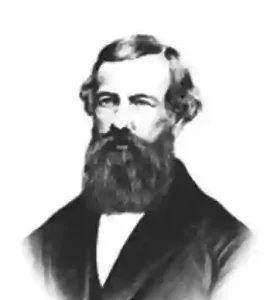
1854: The First Demonstration of the Safety Elevator
In 1854, Otis showcased his safety elevator at the Crystal Palace World’s Fair in New York.
He rode the elevator up slowly, drawing a crowd.
As the elevator reached the top, a man cut the supporting rope. To everyone’s surprise, the elevator didn’t fall. It slid down a few inches before the spring stopped it.
Otis loudly said, “Everyone, all is safe!” This moment marked a turning point, helping the public trust elevators.
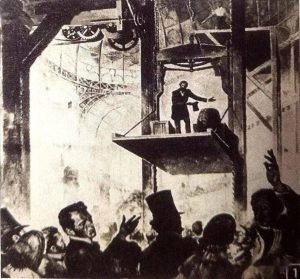
1857: The First Passenger Elevator in a Commercial Building
In 1857, Otis installed the first steam-powered passenger elevator in the E.V. Howard Building in New York.
Although the five-story building didn’t need an elevator, it hoped the novelty would attract customers.
This elevator moved at less than one foot per second. Today, modern elevators can reach speeds of over 40 feet per second.
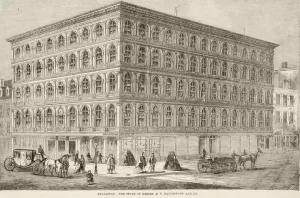
The Controversy Over the First Safety Elevator
Some debate whether Otis’ elevator was truly the first safety elevator.
Other elevators with safety devices existed before 1854.
Otis may not have known about earlier lifts. But, his demonstration was not the first of its kind.
German historian Andreas Bernard believes these demonstrations came from 19th-century engineers’ work.
In fact, Otis’ elevator wasn’t the first passenger elevator in the United States. As early as June 17, 1843, a steam-powered elevator was installed at the Bunker Hill Monument.
The Evolution of Modern Elevators
Early Popularity of Elevators
From the mid-19th century, elevators became a regular part of life.
Most buildings then had no more than four floors, and elevators were slow.
Because of this, elevators were seen as luxury items. They were mostly found in hotels and large cities like Paris, New York, and London. The interiors often had wood paneling, soft seating, mirrors, and chandeliers.
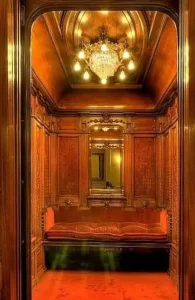
1870: The Arrival of the Hydraulic Elevator
By 1870, Otis elevators had been installed in over 2,000 buildings after 15 years of promotion.
The Fairness Life Building was one of the first high-rise buildings to add an elevator.
During this time, hydraulic engines began to replace steam engines.
1880: The Birth of the Electric Elevator
In 1880, German inventor Werner von Siemens created the first electric elevator.
In 1883, American inventor Schuyler Wheeler also patented an electric elevator.
But, early electric elevators didn’t have automatic doors like today. Many didn’t have doors at all, or the doors had to be closed by hand.
Elevators in the 19th century did not have buttons. Attendants used levers to adjust the speed and stop the elevator at each floor.
As a result, many people were injured when the doors opened or got trapped between floors.
In 1887, JW Mickle invented the automatic door system, solving these safety issues.
The 1890s: Improvements in Electric Elevator Technology
In the 1890s, Frank Sprague invented the first system to control electric elevators. This system connected elevators to circuits or computers.It allowed automatic stops and door control.
In 1895, Otis Elevator Company bought Sprague’s company. This marked a major milestone in elevator technology.
1900: The Rise of Automatic Elevators
By 1900, automatic elevators started to appear. But, many people still didn’t trust them to run without an operator.
In September 1945, 15,000 elevator operators went on strike. This led to businesses in New York stopping for a week, as people couldn’t get to work. Even with temporary workers, accidents happened due to poor training. Some of these accidents led to deaths.
The strike caused a tax loss of about $8 million per day. In the end, it sped up the use of automatic elevators and replaced elevator operators.
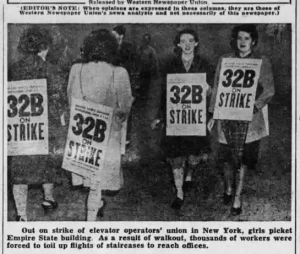
Advances in Modern Elevator Technology
Elevator technology grew quickly in the late 20th century. It focused on improving performance, energy use, and building integration.
1980s: The Introduction of Linear Motor Elevators
In 1982, France, Germany, and Japan developed the linear motor elevator. This technology converts the motor’s motion into direct movement. It eliminates the need for traction ropes and gearboxes. As a result, elevator speed, performance, and design flexibility improved.
Japan first used this technology in 1989. This marked the beginning of commercial use of linear motor elevators. It also laid the groundwork for future ultra-high-speed, rope-less elevators.
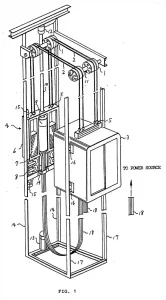
1990s: Development of Variable Frequency Drive and Machine-Room-Less Elevators
In 1990, Mitsubishi Electric of Japan used variable frequency drive (VFD) technology in hydraulic elevators. This technology makes the elevator start and stop more smoothly. It also reduces power consumption.
In 1996, Kone from Finland introduced the MonoSpace elevator. It didn’t need a machine room and used new motors and speed controls, saving space and reducing costs.
This design placed major components, like the hoist machine, in the elevator shaft or at the top or bottom. It saved space and reduced construction costs. It also gave architects more flexibility. This made it popular in the elevator industry.
Conclusion
The development of elevators has changed architecture and changed the real estate market and our daily lives. From simple lifts to modern automatic elevators, they have increased the value of upper-floor properties and changed the market.
Elevator innovation began with ancient Greek and Roman prototypes. It continued with the Industrial Revolution and Otis’ safety elevator. This innovation has driven urban growth and still shapes our cities today.
Fun Facts About Elevator History
The First Person to Patent an Elevator
Otis Tufts was the first American to patent a passenger elevator. He called his elevator the “Vertical Railway” and designed it as an enclosed cabin.
In 1861, Elisha Otis received his elevator patent.
His invention was a slow but safer open-platform freight lift, not a passenger elevator. Otis installed these lifts in places like the Fifth Avenue Hotel in New York, where they ran until the 1870s.
Later, Otis’ company succeeded, and Tufts University named in his honor.
The Origins and Development of Elevator Music
Elevator music, also called background music, is an interesting part of elevator history.
In the 1920s, elevators began playing music to help passengers relax and create a more comfortable atmosphere.
The term “mood music” was first used in 1934 by a company that made this type of music. Over time, it became popular in elevators, malls, and offices. It aimed to boost productivity and encourage shopping.
But, by the 1960s, elevator music started to lose popularity due to its repetitive style.
The History of Elevator Shafts
The First Elevator Shaft
Before inventing elevators in 1853, Peter Cooper built elevator shafts for the Cooper Union Building.
He believed people would soon need passenger elevators, so he chose a cylindrical shaft design.
He finished the shaft four years before Otis installed the first passenger elevator. It became the world’s first space designed for an elevator.


